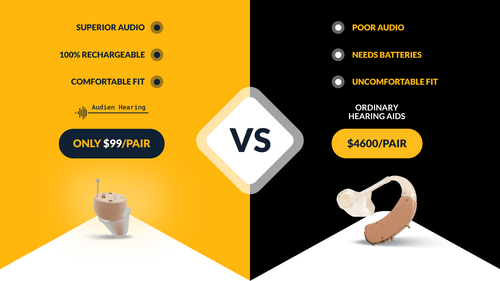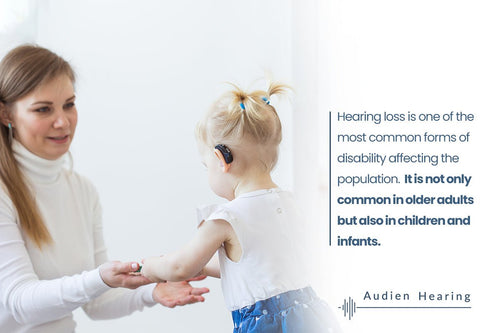Rechargeable hearing aids are quickly becoming the preferred type of hearing aid for consumers. That said, most of the market is still using disposable battery powered hearing aids (about 89% of the market according to a study done by HearingTracker.com). This is because until a few years ago, major hearing aid manufacturers weren’t selling rechargeable products.
The market is shifting, though; most consumers now expect and prefer rechargeable hearing aids, and for good reason! There are many benefits to rechargeable hearing aids, and we’ve compiled everything for you here to learn more.
Rechargeable Hearing Aid Guide
Since there is a lot to research when looking for a new pair of rechargeable hearing aids, we've put together this guide! Click below to skip to any section, or read on to learn everything there is to know about rechargeable hearing aids.

- Rechargeable vs disposable
- Benefits of rechargeable hearing aids
- Types of rechargeable hearing aids
- Rechargeable hearing aid prices
- Frequently asked questions
- Audien rechargeable hearing aids
Rechargeable vs Disposable

When looking for a new hearing aid, it’s important to consider whether you want to find something that’s rechargeable or disposable. Options with disposable batteries have traditionally been the standard on the market.
Disposable Hearing Aid Batteries

Disposable hearing aid batteries typically last anywhere from 3-10 days depending on size. They have a few benefits:
Portability
Hearing aids that use disposable hearing aid batteries are ready to use at all times. You don’t need to remember to bring your charger with you wherever you may go. Just bring batteries and the hearing aids and you’re good.
Accessibility
For hearing aids with disposable batteries, as long as you have batteries on hand, you’ll never have a moment where your device won’t power on. People with rechargeable hearing aids may have to go days without using their device if they forget or lose their charger, so disposable batteries pose an advantage when it comes to accessibility. Disposable hearing aid batteries are easily and readily available at retail locations everywhere, so there are few situations where you can’t get batteries.
Rechargeable Hearing Aids

Rechargeable hearing aids use a lithium powered battery that can be charged when not in use. Most rechargeable hearing aids now can last for a full day’s use on a full charge. This makes it easy for people to charge their hearing aids at night, and use it all day, similar to their cell phones.
Rechargeable hearing aids have their perks. They remove the cost of buying batteries and the hassle of replacing tiny batteries regularly. For many with arthritis or other dexterity issues, this can be difficult or even painful.
That said, rechargeable hearing aids do have their cons; if you lose or forget your charger when going somewhere, you may not be able to power on your device for days until you get a replacement, since many chargers are custom based on the manufacturer.
Benefits of Rechargeable Hearing Aids

Rechargeable hearing aids are becoming the preference of the average consumer for good reason. Here are some of the benefits of rechargeable hearing aids:
Cost
With batteries that last only a week at a time, most people using disposable batteries are using 50 batteries every year, which can cost anywhere from $50 to $100 per year depending on the battery type. For those who are buying a higher end device that may not be a problem, but for people who need to keep prices low, that’s a big extra expense. Rechargeable hearing aids don’t have that added cost.
Convenience
Making sure to have batteries on hand is inconvenient. You have to sign up for a service that delivers them regularly, or buy them at the store. Plus, nobody likes having to deal with things running out of battery, especially when it’s something as important as your hearing aids. With rechargeable hearing aids, you don’t always have to remember to have batteries on hand when traveling or going somewhere, which can be inconvenient; you just need to remember your charger and then you won’t have to worry about any of those other hassles.
Ease of Use
Rechargeable hearing aids are much easier to use than their disposable battery powered counterparts, because they remove one of the biggest problems in disposable battery powered hearing aids: changing the battery.
Disposable batteries are very small and difficult to maneuver. Changing the batteries in your hearing aids can be hard! The hearing aids are pretty small, and the batteries are even smaller.
For most people, it’s tricky to change your hearing aids; and for people with dexterity problems or arthritis, it’s even more difficult. With rechargeable hearing aids, you never have to deal with changing tiny disposable batteries out.
Improved Battery Life
Initially upon the release of rechargeable hearing aids, battery life was an issue. A full charge wouldn’t last a full day for the user.
Now, rechargeable hearing aids have improved to the extent that a full charge lasts a full day. Users can plug in their rechargeable hearing aids at night and enjoy a full day’s use the next day.
Environmentally Friendly
Disposable batteries can be recycled, but that can be inconvenient and many don’t end up properly disposing of their batteries. That means that millions of hearing aid batteries every year are thrown in the trash. Batteries have toxic materials that can be bad for the environment if not disposed of properly. By using rechargeable hearing aids, your carbon footprint stops at the device itself.
Types of Rechargeable Hearing Aids

There are two primary types of rechargeable hearing aids: lithium ion and silver-zinc. Lithium ion rechargeable hearing aids are the most widely used solution. Silver-zinc rechargeable batteries are used because they are smaller and more compact, and are a good retrofitted rechargeable solution for hearing aids that use disposable batteries.
Lithium Ion Rechargeable Hearing Aids
Most rechargeable hearing aids use lithium ion technology. Lithium ion batteries are commonly used in cell phones and other electronics. Lithium ion batteries are useful because of their short charge time and strong battery life.
Silver-Zinc Rechargeable Batteries
There are silver-zinc rechargeable batteries that are the same size and shape of normal disposable batteries, and can be used with devices meant for disposable batteries. The batteries themselves are rechargeable so you don’t have to keep buying new batteries.
These tend to have a shorter lifespan than lithium ion batteries, but they are still a potential cost saving option. That said, most manufacturers are trending toward making lithium ion rechargeable hearing aids, so rechargeable batteries don’t seem to be as much at the forefront.
Rechargeable Hearing Aid Prices

Rechargeable hearing aids can vary in price, ranging from only $89/pair for our Audien EV1 Hearing Aids to more than $5,000/pair for higher end models from other manufacturers. Higher end rechargeable hearing aids include advanced features like bluetooth, customization based on your audiogram, digital noise filtering and more.
That said, many people with mild to moderate hearing loss can use a one size fits all approach. Non customized rechargeable hearing aids with digital technology can be found for $500 to $1000/pair, and analog rechargeable hearing aids can be as low as $89.
Frequently Asked Questions

How Much Do Rechargeable Hearing Aids Cost?
Rechargeable hearing aids cost anywhere from $89 to $5,000+ for a pair depending on the technology. Analog rechargeable hearing aids are on the low end of the price spectrum, while non customized digital rechargeable hearing aids tend to be $500 to $1000/pair. Customized, high end rechargeable hearing aids that you get from an audiologist are on average $4,600/pair.
What is the Battery Life of Rechargeable Hearing Aids?
The battery life of rechargeable hearing aids varies by manufacturer and model. Generally, bigger devices have longer battery life because they are able to house a bigger lithium ion battery. Today, most hearing aids last for a full day of usage off of one charge.
Audien EV1 rechargeable hearing aids have 28 hours of battery life and Audien EV3 rechargeable hearing aids have 22-24 hours of battery life (due to their smaller size). Many higher end models have up to 30 hours of battery life on one charge.
How Long Does it Take to Charge Rechargeable Hearing Aids?
Charge time varies by manufacturer and model of hearing aid. Many higher end hearing aids have a charge time of only 3-4 hours. Audien rechargeable hearing aids have a charge time of about 6-8 hours.
How Do Rechargeable Hearing Aids Work?
Rechargeable hearing aids use lithium ion batteries that are able to capture and hold a charge for an extended period of time.
Is There a Risk of Fire With Rechargeable Hearing Aids?
Lithium ion batteries are very low risk for fire, because the batteries are sealed within the hearing aid body. If there is anything internal to the device that is exposed, you should get it repaired or replaced.
Audien Rechargeable Hearing Aids

Audien rechargeable hearing aids are discreet and powerful, featuring a sleek in ear design. Audien’s EV1 rechargeable hearing aids are only $89/pair, and Audien’s EV3 rechargeable hearing aids are only $249/pair, complete with wireless magnetic charging dock. At Audien Hearing our mission is to make hearing affordable for everyone, so our products are the lowest possible. Learn more about us at www.audienhearing.com.
Conclusion
Rechargeable hearing aids are the new norm for the hearing aid consumer. It’s important to consider the pros and cons of rechargeable versus disposable battery powered hearing aids. Rechargeable hearing aids have a lot of benefits, from cost to convenience, and there are a lot of different types of rechargeable hearing aids. Look for one that matches your budget and your level of hearing loss - the important thing to know is that there are options out there for all budgets and levels of hearing loss.
We hope this resource was helpful to you on your journey to better hearing. Thanks for reading and good luck on finding your new hearing aids!













